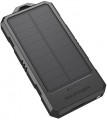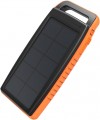Max. power (per 1 port)
The maximum power that the power bank, theoretically, is capable of delivering to one rechargeable device. Usually, this power is achieved under the condition that no other device is connected to the battery (although exceptions to this rule are possible). And if you have ports with different charging currents or support multiple fast charging technologies, this information is given for the most powerful output or technology.
For modern power banks, a power of
10 watts or less is considered quite low; among other things, it usually means that the device does not support fast charging. Nevertheless, such devices are inexpensive and often turn out to be quite sufficient for simple tasks; Therefore, there are many models with similar specs on the market. The power of
12 – 15 W is also relatively small,
18 W can be called the average level,
20 – 25 W and
30 – 50 W is already considered an advanced level and in some solutions this parameter may
exceed 60 W.
In general, higher power output has a positive effect on charging speed, but in fact there are a number of nuances associated with this parameter. Firstly, not only the power bank, but also the gadget being charged should support the appropriate power — otherwise the speed of the process will be limited
...by the specs of the gadget. Secondly, in order to use the full capabilities of the power bank, it may be necessary for it to be compatible with certain fast charging technologies (see "Fast Charging").Power output (all ports)
The total charge power provided by the power bank on all connectors overnight - when devices are connected simultaneously to all charging ports.
This parameter is given due to the fact that the total charge power does not always correspond to the sum of the maximum powers of all available ports. The built-in battery of a power bank often has its own limitation on the output power. Therefore, for example, in a model with two 18 W USB ports, each total charge power can be the same 18 W. Note that the distribution of power among the connectors may be different: in some models it is divided equally, in others it is divided in proportion to the maximum current strength (if it differs on different ports). These nuances should be clarified using the detailed characteristics of the charging connectors.
If you plan to regularly use all power bank connectors at once, you should pay attention to this indicator.
Full charge time
The time required to fully charge a battery discharged “to zero”. Features of the charging process in different models may be different, respectively, and the time required for this may differ markedly even with the same capacity.
Fast-charging batteries tend to be more expensive. Therefore, choosing this option makes sense if you do not have much time to replenish your energy supply — for example, for hiking. However, keep in mind that charging at full speed may require a charger that supports certain fast charging technologies (see below).
It must also be said that in most modern batteries, the charging speed is uneven — it is highest at the several first percent from zero, then gradually decreases. Therefore, the time required to replenish the energy supply by a certain percentage will not be strictly proportional to the total claimed charge time; moreover, this time will depend on how much the battery is already charged at the time the procedure starts. For example, charging from 0 to 50% will take less time than from 50 to 100%, although both there and there we are talking about half the capacity.
Features
Additional functions and features provided in the design of the power bank. Such features may include, but are not limited to,
an info display, a
USB hub mode, a photocell for
solar charging, a lighting source (
flashlight or
lamp), and a
shock -resistant body. Here's a more detailed description of each of these options:
— Info display. Own display installed on the power bank body. As a rule, it has a simple LCD matrix capable of displaying 2 - 3 characters and, in some cases, individual special icons. However, even such a screen provides a lot of additional information, makes it easier to manage the power bank and monitor its status.
— USB hub. Possibility of working as a USB hub (splitter). In this mode, the external battery’s own USB connectors act as USB inputs of a PC or laptop to which the power bank is connected. The connection itself, as a rule, is also carried out using the USB standard, and the battery can be charged. This function is convenient primarily because it allows you to use one USB port simultaneously to charge the power bank and connect a peripheral device (or even several). However, it does not hurt to make sure that the power supply of this port is sufficient to provide all these functions; and the charging speed may be quite slo
...w. If the power bank is fully charged, it can also be useful as a classic USB hub: to increase the number of ports available for connecting peripherals, and also as a kind of remote USB extension cable (for example, if there is a free USB port only on the rear panel of the system unit, which is difficult to get to).
- Flashlight. In this case, a flashlight means a built-in light source of relatively low power, usually directional (as opposed to the lamp described below). Such a source performs an auxiliary function; it can be useful, for example, for illuminating the road at night, for short-term illumination in a dark room (basement, cellar), etc.
- Lamp. Built-in light source, usually in the form of an oblong panel of several LEDs; such a panel can be made folding. Unlike flashlights (see above), lamps provide not directional, but diffused light, which has a shorter range, but covers a larger space. Such lighting can be useful, for example, for reading, for illuminating a room during a power outage, and even for creating a certain atmosphere.
- Shock protection. Enhanced protection against impacts and shocks. The specific degree of such protection may vary; it should be clarified according to the official characteristics; however, most models in this category are capable of at least transferring a fall from a height of about 1 - 1.2 m onto a flat hard surface without consequences. Well, in any case, such devices will be more resistant to mechanical stress than conventional ones. It is also worth noting that shock protection in modern power banks is most often combined with protection from dust and moisture (see above), although there are exceptions to this rule.
— Charging from the sun. Possibility of charging the power bank from the sun or other bright light source. To do this, a corresponding device is installed in the body - a solar battery (photocell). This function can be especially useful during a long stay away from civilization - for example, on a hike. And although the efficiency of solar panels in general is not very high, when exposed to bright light for a long time, you can accumulate quite a lot of energy.
